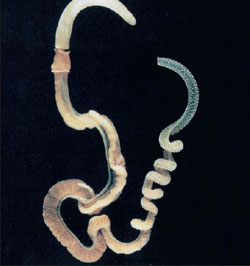Chaetognaths and Hemichordates
 |
| An enteropneust hemichordate |
In the mid-nineteenth century, with interest in the origin of the chordates running high, a group of wormlike marine invertebrates of unknown relationship began to attract attention with their chordatelike characteristics. In 1885 W. Bateson named them Hemichordata and forcefully argued that these organisms should be included in phylum Chordata. Bateson pointed to several hemichordate structures that he believed were homologous with comparable features in chordates: a dorsal nerve cord, gill slits, and, most importantly, a sac-like evagination of the mouth region that he interpreted as a notochord. The notochord, a rodlike, supportive structure lying dorsal to the gut of early growth stages of all chordates, is a key distinguishing feature of the phylum Chordata. If the hemichordates possessed a notochord— even half a notochord—they had to be chordates.
Unfortunately, the structure that Bateson interpreted as a notochord neither looks like a notochord nor develops like a notochord. These and other problems with giving the hemichordates membership in the chordate club were noted in the 1930s, but by this time the concept had become firmly established in textbooks and began to assume a life of its own. Some zoologists and texts doggedly continued to assign subphylum Hemichordata to phylum Chordata for 25 or more years. Eventually most zoologists agreed that hemichordates should be viewed as a distinct phylum of “lesser” deuterostomes. Bateson’s name—Hemichordata—has stuck, however, and oddly enough seems appropriate for a group of animals that, although lacking a notochord, does bear certain characters in common with true chordates. As the likely sister group of chordates, hemichordates are indeed half (or part) chordates.
Deuterostomes include, along with Echinodermata two other phyla: Hemichordata and Chordata. Two chordate subphyla—Urochordata and Cephalochordata— are also invertebrate groups. Phylum Chaetognatha traditionally has been included among deuterostomes, but this arrangement is not supported by recent molecular evidence.* Chaetognaths do bear a number of deuterostome characters, however, and we will continue to include them in this section for the present. These phyla have enterocoelous development of the coelom and some form of radial cleavage.




